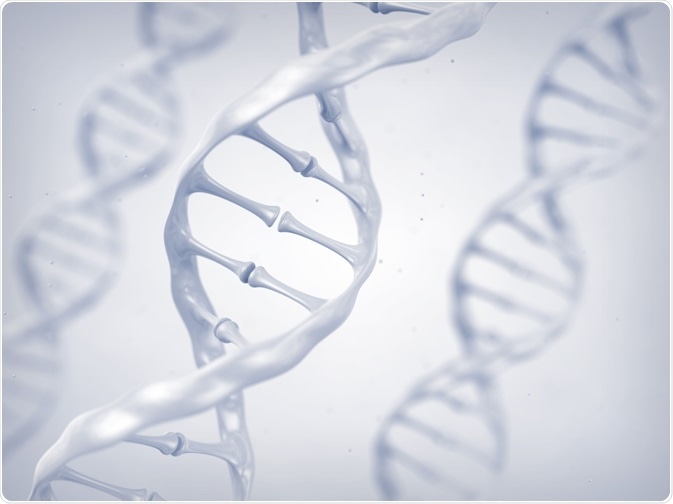DNA is one of the principal organic molecules for life. The information that is encoded within its structure controls the development of an organism from its genesis to its death.
 Image Credits: nobeastsofierce / Shutterstock.com
Image Credits: nobeastsofierce / Shutterstock.com
Many technologies have been developed since the determination of the double-helical structure of DNA in the 1950s, which has benefitted our society. One of the more recent technologies to emerge within the field is DNA phenotyping, which is proving to be a revolutionary, albeit controversial, technique and subject.
Principles behind the technology
DNA phenotyping is the science of predicting an organism’s observable physical or biochemical characteristics (phenotype) by using only genetic information from DNA sequencing or genotyping. Another commonly used term for DNA phenotyping is molecular photofitting. The technique is primarily used to predict a person’s physical appearance and/or ancestry for forensic purposes.
Using a genome-wide association study (GWAS) approach, genetic variants associated with the target trait are discovered. This involves testing many (in the region of hundreds of thousands/millions) of single-nucleotide polymorphisms (SNPs) that are associated with the trait of interest. Then, using predictive modeling, trait predictions about new subjects are made.
There are two methods to predict Human phenotypes from DNA – direct and indirect. Direct methods involve using statistical methodologies to infer trait value and mechanistically linking genetic variants with the relevant phenotype’s variable expression.
In indirect methods, trait value is inferred by using variants that are associated with genetic component(s) of ancestry (for example, Ancestry Informative Markers, which are SNPs that vary in frequency across major Human populations) and combining these with appropriate statistical methodologies. Direct methods are preferable. However, depending on the phenotype’s genetic architecture, this is not always possible.
One of the key GWAS quality control steps is that of biogeographic ancestry determination. In this methodology, new subjects are compared to individuals with known ancestry by using techniques such as genome-wide human genetic clustering (such as the 1000 Genomes project.) In this way, the appearance of a certain individual can then be predicted.
There have been several recent developments in the field of DNA phenotyping. Some loci which are useful for DNA phenotyping and have been found include 15 that are responsible for facial features, identified in 2018. A recently developed online tool, which is available to both the public and law enforcement, is the HIrisPlex-S System, which can be used to predict hair, eye, and skin color in humans using pigmentation information.
DNA phenotyping differs from DNA profiling. However, DNA profiling can be used in tandem with the technology once a suspected individual is identified.
Uses of DNA phenotyping
DNA phenotyping is primarily used in the field of forensic science. It is used to narrow the pool of potential suspects or identify remains by learning about the ancestry and appearance of a person.
There have been many cases in recent years wherein DNA phenotyping has helped investigators to identify suspects or human remains. One of the most famous cases was the murder of Candra Alston and her daughter Malaysia Boykin in Columbia, South Carolina. In 2015, the use of a composite image by police, the first to be produced entirely from a DNA sample, led to the charging of Kenneth Canzater Jr. with the crime in 2017.
The image was produced by Parabon NanoLabs and consisted of a digital mesh of predicted facial morphology, which was then overlaid with textures of predicted eye, hair, and skin color.
Another field finding applications for DNA phenotyping is archaeology. Researchers in this field can utilize the technique to help understand what our ancestors looked like.
Chinese use of DNA phenotyping raises ethical concerns
However, DNA phenotyping has potentially darker applications due to its potential to accurately predict an individual’s appearance and ancestral lineage. One such application that is raising ethical concerns within the legal and scientific communities is the recent use of DNA phenotyping by Chinese researchers and the government.
In recent years, reports have surfaced that by using blood samples from Uighurs and other predominantly Muslim minority groups, researchers have been attempting to innovate the technology.
The main concern raised is that by attempting to improve facial recognition on a mass scale by government agencies, this technology could be misused to provide improved mass surveillance programs and could be applied to racial profiling.
China is not the first government to attempt to improve this developing technology. Ethicists have raised concerns over recent years about DNA phenotyping’s use by governmental agencies and law enforcement, which have led to a slew of legislation and best practice in the field.
Some concerns raised internationally about China’s use of the technology pertaining to doubts about consent, as well as the Chinese government’s crackdown on ethnic minorities such as the Uighur community.
DNA phenotyping: A potentially revolutionary technology with potential ethical ramifications.
DNA phenotyping represents one of the most interesting areas of ongoing genetic research, which is applicable to many other fields. However, it has the potential for more ethically questionable applications.
Clearly, as this technology develops in the future, stringent ethical guidelines and practices will have to be implemented on an international scale to prevent potential misuse of this exciting and cutting-edge technique by governments and law enforcement agencies.
Sources
Sturm, R.A & Frudakis T.N. (2004) Eye colour: portals into pigmentation genes and ancestry Translational Genetics Vol. 20 Issue 8, Pgs. 327-332 https://doi.org/10.1016/j.tig.2004.06.010
Claes, P et al. (2018) Genome-wide mapping of global-to-local genetic effects on human facial shape Nature Genetics 50, 413-423 https://www.nature.com/articles/s41588-018-0057-4
Shriver, M.D et al. (1997) Ethnic-affiliation estimation by use of population-specific DNA markers Am J Hum Genet. Vol. 60, Issue 4, Pgs. 957-964 https://www.ncbi.nlm.nih.gov/pmc/articles/PMC1712479
China is using DNA samples to try to re-create the faces of Uighurs, MIT Technology Review Dec 3, 2019 www.technologyreview.com/.../
Further Reading
Last Updated: Mar 10, 2020